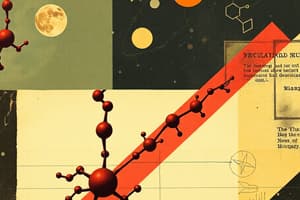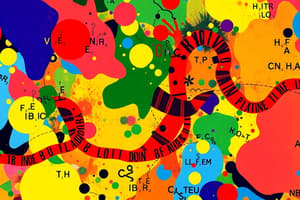Podcast
Questions and Answers
Which statement regarding bases in DNA is false?
Which statement regarding bases in DNA is false?
- They have vertical stacking interactions.
- Pyrimidines are aromatic; purines are not. (correct)
- They absorb UV light.
- They hydrogen bond between two or more complementary DNA strands.
What stabilizes the double helix in DNA?
What stabilizes the double helix in DNA?
Metal cations shield negative charges of backbone phosphates and base stacking interactions between successive base pairs.
What other name can be given to a nucleotide?
What other name can be given to a nucleotide?
- Glycosylated nucleoside (correct)
- Purinated pentose
- Deoxyribonucleotide
- Nucleoside phosphate
Which of the following is NOT a pyrimidine base?
Which of the following is NOT a pyrimidine base?
Which of the following is NOT part of a deoxyribonucleotide?
Which of the following is NOT part of a deoxyribonucleotide?
What name is given to the nucleotide found in DNA and NOT in RNA?
What name is given to the nucleotide found in DNA and NOT in RNA?
A property of nucleotide bases that affects the three-dimensional structure of nucleic acids is:
A property of nucleotide bases that affects the three-dimensional structure of nucleic acids is:
In a sample of DNA isolated from an unidentified species of bacteria, adenine makes up 28% of the total bases. Which statement is false about the relative proportions of the bases in the DNA sample?
In a sample of DNA isolated from an unidentified species of bacteria, adenine makes up 28% of the total bases. Which statement is false about the relative proportions of the bases in the DNA sample?
Which statement is true about the three-dimensional structure of DNA?
Which statement is true about the three-dimensional structure of DNA?
Study Notes
Nucleotides and Nucleic Acids
- Nucleotides have three components: a nitrogenous base, a pentose, and one or more phosphates
- A nucleoside is a molecule without a phosphate group
- Nitrogenous bases include pyrimidines (cytosine, thymine, uracil) and purines (adenine, guanine)
Nucleotide Bonds
- N-β-glycosyl bond: covalently joins the 1′ carbon of the pentose to the base (at N-1 of pyrimidines and N-9 of purines)
- Phosphate is esterified to the 5′ carbon
Nitrogenous Bases
- Major purine bases: adenine (A) and guanine (G)
- Major pyrimidine bases: cytosine (C), thymine (T), and uracil (U)
- Thymine is only found in DNA, while uracil is only found in RNA
Nucleotide Nomenclature
- Table 8-1 shows the nomenclature for nucleotides, nucleosides, and nucleic acids
Nucleotide Pentoses
- Two kinds of pentoses: 2′-deoxy-D-ribose (in DNA) and D-ribose (in RNA)
- Both are in their β-furanose (closed five-membered ring) form
Deoxyribonucleotides and Ribonucleotides
- Deoxyribonucleotides are the structural units of DNA
- Ribonucleotides are the structural units of RNA
Phosphodiester Bonds
- Phosphodiester linkage: a covalent bond that joins successive nucleotides of both DNA and RNA
- Between the 5′-phosphate group of one nucleotide unit and the 3′-hydroxyl group of the next nucleotide
Hydrolysis of DNA and RNA
- Under alkaline conditions, RNA is rapidly hydrolyzed due to the presence of 2′-hydroxyl groups
- DNA is not rapidly hydrolyzed
Solubility of Nucleotides
- Hydrophobic and relatively insoluble in pH 7.0 water
- Leads to stacking interactions (van der Waals and dipole-dipole)
- Charged and more soluble at acidic or alkaline pH values
Studying That Suits You
Use AI to generate personalized quizzes and flashcards to suit your learning preferences.
Description
This quiz covers the roles of nucleotides in cellular metabolism, including energy currency, response to hormones, and structural components of enzymes and metabolic intermediates.




